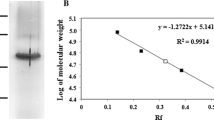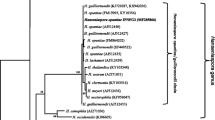Abstract
The first International Pichia anomala Symposium provided a survey of past, recent and ongoing research on this yeast. The research community working with this yeast has focussed on several areas. Based on molecular data, a revision of the taxonomy is required: the name P. anomala is no longer applicable, as the genus Pichia is polyphyletic. The current debate centres on whether the yeast should be designated as Wickerhamomyces anomalus or if the previous name, Hansenula anomala, should be re-instated. The anti-microbial activities of this yeast received considerable attention during the symposium. H. anomala has been extensively studied as a biopreservation agent in many different post-harvest systems. Several mechanisms account for its anti-microbial activities, including the production of killer proteins and toxic volatile metabolites. Anti-idiotypic antibodies generating an “internal image” of a killer protein have been found to possess therapeutic activity against a broad range of microorganisms. A great diversity of H. anomala strains was reported at the symposium. Strains have been isolated from several food and feed systems and even from the intestine and reproductive organs of a malaria vector (Anopheles stephensi). Feed and food supplemented with certain H. anomala strains show an improved quality due, for example, to the addition of advantageous proteins and phytase activity. However, a number of apparent opportunistic pathogenic strains have also been isolated. Strain differentiation, especially the recognition of potentially pathogenic isolates, is an important challenge for the future commercialisation of this yeast. Future industrial and agricultural application of this yeast also raises questions of the economics of large-scale production, its survival during storage (formulation) and of safety regulations, all of which require further investigation.
Similar content being viewed by others
References
Barnett JA (1998) A history of research on yeasts 1: work by chemists and biologists 1789–1850. Yeast 14:1439–1451
Bhardwaj S, Sutar R, Bachhawat AK, Singhi S, Chakrabarti A (2007) PCR-based identification and strain typing of Pichia anomala using the ribosomal intergenic spacer region IGS1. J Med Microbiol 56:185–189
Brooks PH, Beal JD, Niven SJ (2001) Liquid feeding of pigs: potential for reducing environmental impact and for improving productivity and food safety. Rec Adv Anim Nutr Aust 13:49–63
Daniel HM, Moons MC, Huret S, Van der Meulen R, Vrancken G, De Vuyst L (2010) The sourdough ecosystem and Wickerhamomyces anomalus (= Pichia anomala). Antonie van Leeuwenhoek (this issue)
De Ingeniis J, Raffaelli N, Ciani M, Mannazzu I (2009) Pichia anomala DBVPG 3003 secretes a ubiquitin-like protein that has antimicrobial activity. Appl Environ Microbiol 75:1129–1134
Druvefors UÄ, Passoth V, Schnürer J (2005) Nutrient effects on biocontrol of Penicillium roqueforti by Pichia anomala J121 during airtight storage of wheat. Appl Environ Microbiol 71:1865–1869
Fredlund E, Blank LM, Schnürer J, Sauer U, Passoth V (2004a) Oxygen- and glucose-dependent regulation of central carbon metabolism in Pichia anomala. Appl Environ Microbiol 70:5905–5911
Fredlund E, Druvefors UÄ, Olstorpe MN, Passoth V, Schnürer J (2004b) Influence of ethyl acetate production and ploidy on the anti-mould activity of Pichia anomala. FEMS Microbiol Lett 238:133–137
Friel D, Pessoa NMG, Vandenbol M, Jijakli MH (2007) Separate and combined disruptions of two exo-beta-1, 3-glucanase genes decrease the efficiency of Pichia anomala (strain K) biocontrol against Botrytis cinerea on apple. Mol Plant Microbe Interact 20:371–379
Hazen KC (1995) New and emerging yeast pathogens. Clin Microbiol Rev 8:462–478
Jijakli MH (2010) Pichia anomala in biocontrol for fruits: 20 years of fundamental and practical research. Antonie van Leeuwenhoek (this issue)
Kagiyama S, Aiba T, Kadowaki K, Mogi K (1988) New killer toxins of halophilic Hansenula anomala. Agric Biol Chem 52:1–7
Kalkanci A, Dizbay M, Turan O, Fidan I, Yalcin B, Hirfanoglu I, Kustimur S, Aktas F, Sugita T (2010) Nosocomial transmission of Candida pelliculosa fungemia in a pediatric intensive care unit and review of the literature. Turk J Pediatr 52:42–49
Kaur P, Singh B, Böer E, Straube N, Piontek M, Satyanarayana T, Kunze G (2010) Pphy—a cell-bound phytase from the yeast Pichia anomala: molecular cloning of the gene PPHY and characterization of the recombinant enzyme. J Biotechnol 149:8–15
Kurtzman CP (2010) Systematics of Wickerhamomyces (Pichia) anomalus and its relatives. Antonie van Leeuwenhoek (this issue)
Kurtzman CP, Robnett CJ, Basehoar-Powers E (2008) Phylogenetic relationships among species of Pichia, Issatchenkia, and Williopsis determined from multigene sequence analysis, and the proposal of Barnettozyma gen. nov., Lindnera gen. nov., and Wickerhamomyces gen. nov. FEMS Yeast Res 8:939–954
Laitila A, Juvonen R, Sarlin T, Kotaviita E, Huttunen T, Wilhelmson A (2010) Pichia anomala in malting. Antonie van Leeuwenhoek. doi:10.1007/s10482-010-9511-8
Magliani W, Conti S, Cassone A, De Bernardis F, Polonelli L (2002) New immunotherapeutic strategies to control vaginal candidiasis. Trends Mol Med 8:121–126
Melin P, Schnürer J, Håkansson S (2010) Formulation and stabilization of the biopreservative yeast Pichia anomala J121 with long-term storage stability and maintained biocontrol activity. Antonie van Leeuwenhoek (in press)
Murphy A, Kavanagh K (1999) Emergence of Saccharomyces cerevisiae as a human pathogen implication for biotechnology. Enzyme Microb Technol 25:551–557
Naumov GI, Naumova ES (2010) Taxonomy and genetics of the yeast Pichia/Hansenula anomala. Presentation at the 1st P. anomala mini-symposium
Olstorpe M, Passoth V (2010) Pichia anomala in grain biopreservation. Antonie van Leeuwenhoek. doi: 10.1007/s10482-010-9497-2
Olstorpe M, Schnürer J, Passoth V (2009) Screening of yeast strains for phytase activity. FEMS Yeast Res 9:478–488
Olstorpe M, Borling J, Schnürer J, Passoth V (2010) Pichia anomala yeast improves feed hygiene during storage of moist crimped barley grain under Swedish farm conditions. Anim Feed Sci Technol 156:47–56
Passoth V, Schnürer J (2003) Non-conventional yeasts in antifungal application. In: de Winde JH (ed) Functional genetics of industrial yeasts. Springer Verlag, Berlin, pp 297–329
Passoth V, Fredlund E, Druvefors UÄ, Schnürer J (2006) Biotechnology, physiology and genetics of the yeast Pichia anomala. FEMS Yeast Res 6:3–13
Passoth V, Eriksson A, Sandgren M, Ståhlberg J, Piens K, Schnürer J (2009) Airtight storage of moist wheat grain improves bioethanol yields. Biotechnol Biofuels 2:16
Petersson S, Schnürer J (1995) Biocontrol of mold growth in high-moisture wheat stored under airtight conditions by Pichia anomala, Pichia guilliermondii, and Saccharomyces cerevisiae. Appl Environ Microbiol 61:1027–1032
Polonelli L, Morace G (1986) Reevaluation of the yeast killer phenomenon. J Clin Microbiol 24:866–869
Polonelli L, Magliani W, Conti S (2010) From Pichia anomala killer toxin through killer antibodies to killer peptides for a comprehensive anti-infective strategy. Antonie van Leeuwenhoek. doi: 10.1007/s10482-010-9496-3
Prasad D, Arun S, Murugesan A, Padmanaban S, Satyanarayanan RS, Berchmans S, Yegnaraman V (2007) Direct electron transfer with yeast cells and construction of a mediatorless microbial fuel cell. Biosens Bioelectron 22:2604–2610
Ricci I, Mosca M, Damiani C, Scuppa P, Rossi P, Capone A, Esposito F, Alma A, Sacchi L, Bandi C, Daffonchio D, Favia G (2010) Wickerhamomyces anomalus inhabits the midgut and reproductive organs of the Asian malaria vector Anopheles stephensi. Antonie van Leeuwenhoek (in press)
Schnürer J, Jonsson A (2010) Pichia anomala J121: a 30-year overnight near success biopreservation story. Antonie van Leeuwenhoek. doi:10.1007/s10482-010-9509-2
Sundh I, Melin P (2010) Safety and regulation of yeasts intentionally added to the food or feed chains. Antonie van Leeuwenhoek (this issue)
Vaughan-Martini A, Martini A (1995) Facts, myths and legends on the prime industrial microorganism. J Ind Microbiol 14:514–522
Vohra A, Kaur P, Satyanarayana T (2010) Production, characteristics and application of the cell bound phytase of Pichia anomala. Antonie van Leeuwenhoek. doi: 10.1007/s10482-010-9498-1
Vrancken G, De Vuyst L, Van der Meulen R, Huys G, Vandamme P, Daniel HM (2010) Yeast species composition differs between artisan bakery and spontaneous laboratory sourdoughs. FEMS Yeast Res 10:471–481. doi: 10.1111/j.1567-1364.2010.00621.x
Vustin MM, Shemjakina TM, Rebentish BA, Bytshkova MA, Kharitonov SI, Beljajev SV, Timokhina EA, Sineokij SP (1989) Killer proteins produced by the yeast Hansenula anomala (in Russian). Dokl Akad Nauk SSSR 308:1251–1255
Walker G (2010) Pichia anomala: cell physiology and biotechnology relative to other yeasts. Antonie van Leeuwenhoek. doi:10.1007/s10482-010-9491-8
Young TW, Yagiu M (1978) A comparison of the killer character in different yeasts and its classification. Antonie van Leeuwenhoek 44:59–77
Author information
Authors and Affiliations
Corresponding author
Additional information
Synonyms: Hansenula anomala, Wickerhamomyces anomalus
Rights and permissions
About this article
Cite this article
Passoth, V., Olstorpe, M. & Schnürer, J. Past, present and future research directions with Pichia anomala . Antonie van Leeuwenhoek 99, 121–125 (2011). https://doi.org/10.1007/s10482-010-9508-3
Received:
Accepted:
Published:
Issue Date:
DOI: https://doi.org/10.1007/s10482-010-9508-3




